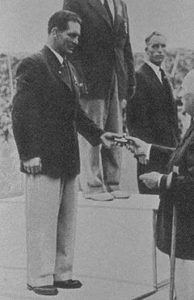Our next series of planned blog entries are going to examine two topics: Olympians who could, at least in theory, be alive and older than our oldest Olympian John Lysak, and medalists for whom we have no information on whether they are alive or deceased. Both of these lists are lengthy, with numerous entries, and since we are in the midst of travelling, we wanted to do something much quicker for this week’s blog post. As it turns out, however, these lists happen to intersect only twice, both on bronze medal-winning wrestlers from the 1948 Games. One is Egyptian light-heavyweight Greco-Roman wrestler Ibrahim Orabi, who we covered already in a previous post. Today, therefore, we are going to focus on just one Olympian: Swiss featherweight freestyle wrestler Adolf Müller.
Müller is not the man in the foreground of the photograph; he is the individual with the moustache in the background.
Adolf Müller competed as a featherweight in both the Greco-Roman and freestyle wrestling tournaments at the 1948 Games. In the former, he was disqualified for being overweight after losing by decision against Norwegian Egil Solsvik in the first round. He was much more successful in the latter competition, however, surviving until the final, where he was defeated by the upcoming silver medalist from Sweden, Ivar Sjölin, which left him with bronze.
Müller never again reached the podium in a major international tournament and, given that his name is fairly common, we could not find any additional information about him and sources in the Swiss sporting world have been unable to help. Müller was born on April 11, 1914, and would be 104 years old if still alive and over four months older than John Lysak. It seems very unlikely that he would still be living, yet have flown almost completely under the radar of the media but, since it is not impossible, we still leave open the idea that he could be alive until it is proven definitively otherwise.
As mentioned above, Müller and Orabi are unique in that they are medalists older than Lysak whose deaths have not been confirmed. This is not surprising, as medalists tend to get far more attention in the media than other Olympians and thus there is more information available about them in general. Yet they are only two of nearly 250 Olympians overall who would be older than Lysak yet whose deaths have not been confirmed. Next week, when we have a little more time, we are going to take a closer look at these Olympians and hopefully share a little insight into the process of how we determine the world’s oldest living Olympian, and what sorts of caveats we have to provide with such a statement. We hope that you’ll join us once again!
